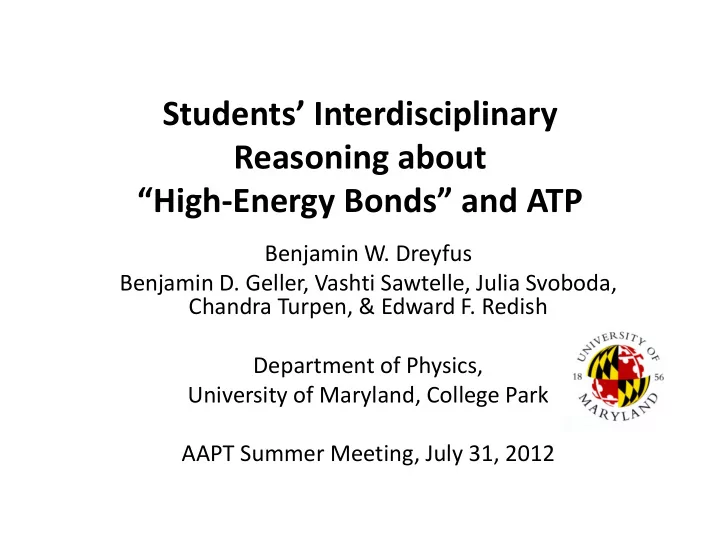

Students’ Interdisciplinary Reasoning about “High-Energy Bonds” and ATP Benjamin W. Dreyfus Benjamin D. Geller, Vashti Sawtelle, Julia Svoboda, Chandra Turpen, & Edward F. Redish Department of Physics, University of Maryland, College Park AAPT Summer Meeting, July 31, 2012
The context: Physics for biologists • New intro physics course for biology undergrads piloted in 2011-12 • Additional focus on energy and thermodynamics, building models that connect physics, biology, and chemistry • Includes chemical bond energy
The context: Physics for biologists • New intro physics course for biology undergrads piloted in 2011-12 Tonight! Poster 2A20 • Additional focus on energy and thermodynamics, building models that connect physics, biology, and chemistry • Includes chemical bond energy
ATP: “the energy currency of the cell” • Produced during respiration and photosynthesis. • In ATP hydrolysis, the phosphate bond is broken, stronger bonds are formed, and the net effect is that energy is released.
ATP: “the energy currency of the cell” • Produced during respiration and photosynthesis. • In ATP hydrolysis, the phosphate bond is broken, stronger bonds are formed, and the net effect is that energy is released.
ATP: “the energy currency of the cell” • Produced during respiration and photosynthesis. • In ATP hydrolysis, the phosphate bond is broken, stronger bonds are formed, and the net effect is that energy is released.
Student “misconceptions” about ATP • Energy is “stored” in a “high-energy bond” • Energy is released when bonds are broken (in ATP or in general) • Treated in the literature as a “misconception” * Biology education: Novick 1976, Gayford 1986 ** Chemistry education: Boo 1998, Teichert & Stacy 2002, Galley 2004
Quiz question (from Galley 2004) An O-P bond in ATP is referred to as a “high-energy phosphate bond” because A. The bond is a particularly stable bond. � B. The bond is a relatively weak bond. C. Breaking the bond releases a significant quantity of energy. � D. A relatively small quantity of energy is required to break the bond.
Quiz results • 79% of our students (N=19) chose C, breaking the bond releases energy • Comparable to Galley’s result of 87%, which he calls a “persistent misconception” • But what are these students thinking?
Interviews • 22 semi-structured interviews with 11 students • Two students, “Gregor” and “Wylie”, discussed the ATP quiz question • Both Gregor and Wylie answered BCD: the “correct” answers and the “misconception”
What did Gregor mean? “I put that when the bond's broken, that's energy releasing. Even though I know, if I really think about it, that obviously that's not an energy-releasing mechanism. Because like, you can't break a bond and release energy , like you always need to put energy in, even if it's like a really small amount of energy, to break a bond.”
Reconciling “When I was taking the test, I guess I was thinking breaking this bond then leads to these other reactions inevitably. That result in an energy release. … I don't [argue] that breaking a bond releases energy, but just like in a larger biological context, that reaction does release energy .”
Tagging the disciplines “I guess that's the difference between like how a biologist is trained to think, in like a larger context , and how physicists just focus on sort of one little thing .”
How to bound the system ATP hydrolysis: (reaction takes place in water) Breaking the Breaking the Formation of phosphate new bonds bond in ATP bond in ATP
How to bound the system ATP hydrolysis: (reaction takes place in water) Breaking the Breaking the Formation of phosphate new bonds bond in ATP bond in ATP “Physics”?
How to bound the system ATP hydrolysis: (reaction takes place in water) Breaking the Breaking the Formation of phosphate new bonds bond in ATP bond in ATP “Physics”? Breaking a bond requires an input of energy
How to bound the system ATP hydrolysis: (reaction takes place in water) Breaking the Breaking the Formation of phosphate new bonds bond in ATP bond in ATP “Physics”? “Biology”? Breaking a bond requires an input of energy
How to bound the system ATP hydrolysis: (reaction takes place in water) Breaking the Breaking the Formation of phosphate new bonds bond in ATP bond in ATP “Physics”? “Biology”? Breaking a bond Breaking the requires an input of phosphate bond in ATP energy releases energy
Summary • Students may appear to have stable “misconceptions”, but Gregor is actually displaying context-dependent resources linked to his perception of the disciplines . • This context-dependent reasoning may be productive!
A vision for interdisciplinary science education • Reasoning within each discipline, using its own tools, in ways that are informed by and coherent with the other disciplines • Making and justifying choices about how to model a phenomenon • Flexibility in moving among models
Thank you This work is supported by the NSF Graduate Research Fellowship (DGE 0750616), NSF-TUES DUE 11-22818, and the HHMI NEXUS grant. Many thanks to the University of Maryland Physics Education Research Group (PERG) and Biology Education Research Group (BERG). Check out the poster: Weds 9:50-10:30am FD07 (IPLS session) Weds 8:30-10:30pm PERC
Recommend
More recommend